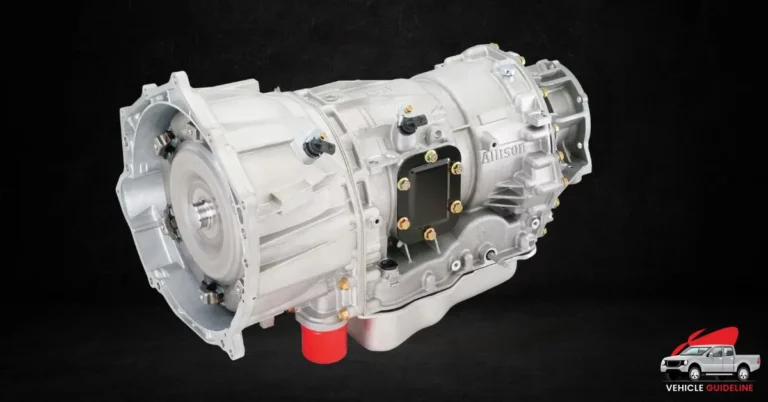245 Vs 265 Tires | 8 Must Know Differences
When purchasing new tires for your vehicle, the options can seem overwhelming. One important decision to make is choosing between 245 vs 265 tires. While they may seem similar at first glance, these two tire sizes have significant differences that can impact your driving experience. From performance and handling to fuel efficiency and aesthetics, understanding the disparities between 245 vs 265 tires is crucial in making an informed choice. The contrasting features of these tire sizes enable you to select the perfect fit for your vehicle’s needs.
What Does 245 Mean on a Tire

The number 245 on a tire refers to the width of the tire in millimeters. This dimension is gauged from one sidewall to the other, denoting the tire’s width when correctly inflated and affixed to a designated rim width. It’s essential to recognize that this figure doesn’t pertain to the precise tread width; instead, it represents the comprehensive width of the tire. Prescribing what 245 means on a tire can be helpful when selecting new tires for your vehicle. It provides valuable information for ensuring proper fitment in conjunction with other numbers and letters found on tires, such as aspect ratio and rim diameter.
Although some individuals may disregard or underestimate the significance of these numbers, they are crucial for ensuring optimal performance and safety while driving. Understanding the meaning of these numbers and their relevance to your vehicle is essential in selecting tires that meet your requirements and offer dependable traction and handling in different driving situations. Therefore, when purchasing new tires or examining your existing ones, it is important to take the time to decipher what those numbers signify as it could have a significant impact.
What Does 265 Mean on a Tire

The width of a tire is indicated by a series of three numbers, like 265, which signifies that the tire is 265 millimeters wide. The second number in this series represents the aspect ratio or profile height of the tire. Knowing these numbers is crucial when selecting tires as they have a significant impact on performance, handling, and fuel efficiency. Moreover, understanding these numbers helps ensure that the chosen tires are compatible with the dimensions of both the car and the wheels.
245 Vs 265 Tires [08 Major Differences]
Choosing between 245 vs 265 tires can affect your driving experience. These sizes have distinct characteristics. Understanding the differences will help you choose the right tires for your needs.
1. 245 Vs 265 Tires Size
Choosing the right tire size for your vehicle involves considering factors like width, driving preferences, and specific needs. A narrower 245 tire offers better traction on snowy or icy roads, while a wider 265 tire provides more grip on dry roads and better stability during high-speed maneuvers. A narrower tire can improve fuel efficiency due to lower rolling resistance, but a wider tire may offer better handling and cornering abilities.
Overall Diameter
The overall diameter of tire sizes is important to consider and can affect speedometer reading and vehicle performance. Switching from a 245 to a 265 tire will increase overall height. Understanding the difference in overall diameters is crucial for informed decisions about tire size. Research and consider how different sizes may impact your driving experience.
Width
The width of a tire affects performance and handling. A narrower tire provides better traction and steering response. A wider tire offers stability and even weight distribution but reduces fuel efficiency. Choosing between the two depends on driver priorities. Consult professionals or the owner’s manual for guidance.
Circumference
The difference in size between 245 and 265 tires can impact performance. Wider tires provide better traction, while narrower tires offer better maneuverability. Choose based on driving preferences, but maintain consistent sizing on all tires.
Sidewall Height
Choosing between 245 and 265 tire sizes depends on sidewall height. Smaller sidewalls enhance performance, while larger sidewalls prioritize comfort.
Revs Per Mile
Tire sizes depend on the revs per mile, which affects performance, fuel efficiency, and driving experience. Larger tires have lower RPMs, resulting in smoother rides and potential fuel savings. Consider driving style, terrain conditions, and desired performance outcomes when making a decision.
2. Price
When considering whether to choose 245 or 265 tires, it is crucial to prioritize factors such as traction, handling, stability, and cornering performance. However, it’s also essential to consider specific driving needs and preferences before making a decision solely based on price. While both tire sizes can offer improved performance on the road, evaluating fuel efficiency requirements will help determine the most suitable option.
It’s worth noting that tire prices can vary significantly depending on brand reputation, seasonal discounts, promotions, and local market demands. Therefore, thoroughly researching these factors will enable you to make a well-informed decision when selecting the right tires for your vehicle.
3. Performance
When it comes to performance, having the right tires can make all the difference. Many car enthusiasts are often torn between choosing 245 or 265 tires for their vehicles. While both options offer their own advantages, understanding how they impact performance is essential.
The width of the tire affects handling and grip. A wider tire provides more traction and stability. Narrower tires offer better maneuverability. Weight distribution is important. Wider tires add weight but improve braking distances. Finding the right balance is key for peak performance.
4. Weight
Weight plays a crucial role. While the variance between 245 vs 265 tires might appear minor, it can profoundly influence your driving encounter. The primary distinction resides in the tire width, with 265 tires being broader than their 245 counterparts. A wider tire (265), generally offers better traction and a larger contact patch with the road surface. This can be especially beneficial for vehicles that are heavier or have more power under the hood. While a narrower tire (245) may provide improved fuel efficiency due to less rolling resistance.
As weight might not always be the primary concern for individuals when they think about tire sizes, it’s a factor that should not be underestimated. Offering insights into how weight influences tire performance can assist you in making a knowledgeable choice and enhancing your driving experience. Therefore, the next occasion you find yourself in need of new tires, remember to consider not only their width but also their capacity to meet your vehicle’s weight demands.
5. Fuel Consumption
When addressing fuel efficiency, tire size plays a significant role. The ongoing debate between 245 and 265 tire sizes revolves around balancing performance and fuel economy. Wider 265 tires provide better traction but increase fuel consumption due to their larger contact area, while narrower 245 tires offer slightly better fuel efficiency but sacrifice some handling capabilities.
The impact of tire size on fuel consumption varies depending on driving habits and road conditions. In wet or snowy conditions where traction is vital, wider 265 tires may be a good choice despite reduced fuel efficiency. In contrast, for city or highway driving with less need for enhanced grip, sticking with narrower 245 tires can optimize fuel economy.
Ultimately, choosing the right tire size involves considering factors like performance needs, local weather, and personal preferences. Before deciding on tire size, evaluate how it will affect your car’s handling and fuel efficiency across various driving conditions.
6. Acceleration
When it comes to selecting the right tires for your vehicle, choosing between 245 and 265 tires can significantly impact acceleration. This difference is due to various factors, including tire width and diameter. A narrower tire (245), requires less engine power to rotate, resulting in quicker acceleration from a standstill due to reduced rotational mass.
On the other hand, opting for a wider tire (265) provides better traction thanks to its larger contact area with the road. While this improved grip may lead to slightly slower initial acceleration, it greatly enhances performance during cornering and high-speed acceleration. Wider tires often come with stiffer sidewalls, enhancing overall vehicle stability and control.
Your choice between 245 vs 265 tires depends on your driving preferences and needs. If you prioritize quick acceleration and agile handling, the narrower tire is the way to go. However, if you value improved traction and stability across various driving conditions, even if it means a slight sacrifice in initial acceleration, then consider the wider tire. Prescribing how different tire sizes affect acceleration can help you make an informed decision tailored to your driving style.
7. Handling Ability
When addressing to handling ability, the choice of tires plays a crucial role. One common dilemma is whether to go for 245 or 265 tires. While both options have their advantages, it’s important to consider your specific driving needs and conditions.
For those seeking enhanced cornering capabilities and increased stability, the 245 tires are an excellent choice. With a smaller contact patch on the road, these tires provide better grip and sharper response during turns. On the other hand, if you prioritize on-road comfort and all-season versatility, the wider 265 tires might be more suitable. Their larger contact area allows for improved traction in various weather conditions while providing a smooth and comfortable ride.
Ultimately, making a decision between 245 vs 265 tires boils down to personal preference and your vehicle’s specifications. It’s always recommended to consult with a tire professional who can assess your specific needs and guide you toward the best option for optimal handling ability on the road ahead.
8. Comfort and Noise
Wondering about the impact of a mere 20-millimeter difference in tire size? Let’s discuss the debate between 245 and 265 tires. While you might assume that wider 265 tires offer a smoother ride, the reality is different. Narrower 245 tires reduce road noise and vibrations in the cabin, providing a more comfortable driving experience, especially on long trips.
The tire width also affects road noise levels, with wider tires generating more noise due to increased contact with the pavement. If you value a peaceful commute or want to minimize cabin noise at high speeds, narrower 245 tires could be your solution. They’re not only quieter but also more fuel-efficient, saving you money at the gas pump!
Rim Application of 245 and 265 Tires
Choosing between 245 vs 265 tire sizes for your vehicle is a common dilemma. Your decision depends on personal preferences and driving habits. Consider tire width; 245 tires are narrower, offering better grip for sports cars. Wider 265 tires provide stability on wet or slippery roads, ideal for SUVs. Also, note that 245 tires generally have lower rolling resistance, potentially improving fuel efficiency compared to 265 tires.
Deciding between 245 vs 265 tires involves various factors, from performance to fuel efficiency. Your driving style and terrain dictate the best choice. Test-driving both sizes under similar conditions helps make an informed decision.
How to Choose the Right Tires for Your Car

Selecting the ideal tires for your vehicle hinges significantly on size. Among the frequently debated options, 245 and 265 tires stand out, appearing deceptively alike but harboring unique traits that can profoundly affect your time on the road.
In essence, tire size refers to width in millimeters. 245 signifies a tire width of 245 millimeters, while 265 means a width of 265 millimeters. This difference affects various aspects of your vehicle’s performance. Wider tires like 265s offer better stability and cornering due to their increased contact area, improving traction during turns. However, they can be less fuel-efficient and generate more noise than narrower 245s, plus they often come at a higher cost.
1. Rim Width
A common dilemma that arises when deciding 245 vs 265 tires revolves around whether the wider option is superior. While a broader tire can potentially offer enhanced traction and stability on the road, it’s crucial to take into account your car’s rim width before reaching a conclusion. Fitting tires that exceed the recommended width for your rims can have adverse effects on handling and increase the likelihood of damage to both the tires and the rims.
2. Vehicle Size
Let’s begin by discussing tire width. A 245 tire is narrower in comparison to a 265 tire. This difference means that if you own a smaller car or a sporty coupe, opting for a 245 tire may be the more suitable choice as it enhances agility and responsiveness on the road. Conversely, if you drive an SUV or a larger truck, a wider tire like the 265 can offer improved stability and traction, particularly when traversing diverse terrains.
Furthermore, it’s imperative to take into account how larger tires can impact fuel efficiency and the accuracy of your speedometer. Wider tires generate greater rolling resistance, which may result in a slight increase in fuel consumption compared to narrower counterparts. Additionally, the installation of larger tires can potentially alter your speedometer readings, as they cover more ground per revolution compared to standard-sized tires. Therefore, it’s crucial to seek advice from experts or refer to reputable online resources to ensure you select the appropriate tire size tailored to your specific vehicle model.
3. Road Condition
Prior to selecting between these two tire widths, it’s crucial to take into account the prevailing road conditions you frequently encounter. If your driving primarily involves dry pavement, opting for wider 265 tires can provide improved handling and responsiveness. However, if you regularly face wet or snowy roads, narrower 245 tires may be the wiser choice, as they enhance safety by boosting traction in such conditions. Ultimately, the optimal tire width selection hinges on achieving a harmonious balance between performance and safety, tailored to your unique driving requirements and the prevalent road conditions in your locality.
Final Thoughts
The choice between 245 vs 265 tires ultimately depends on the specific needs and preferences of each driver. The size difference can impact the overall performance of your vehicle, including handling, fuel efficiency, and comfort. If you prioritize a smoother ride and better fuel economy, the narrower 245 tires may be the better option. On the other hand, if you value enhanced stability and grip, especially in adverse weather conditions, the wider 265 tires might be more suitable. It is advisable to consult with a tire professional or refer to your vehicle’s manufacturer guidelines to ensure proper fitment and maximize performance. Ultimately, making an informed decision will ensure that you select the right tire size for your vehicle. Take the time to weigh the pros and cons of each option before




![GM 5.3 vs 6.0 [12 Differences & Similarities]](https://vehicleguideline.com/wp-content/uploads/2023/08/gm-5.3-vs-6.0-768x377.webp)


![Do I Need OnStar to Use Navigation [08 Unique Features of OnStar]](https://vehicleguideline.com/wp-content/uploads/2023/08/Model-Years-to-Choose-78-768x402.webp)